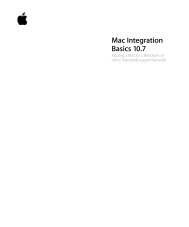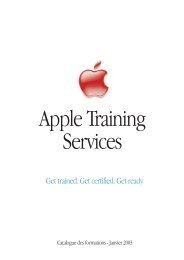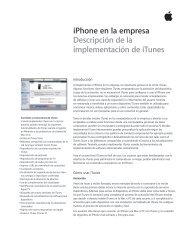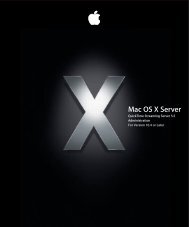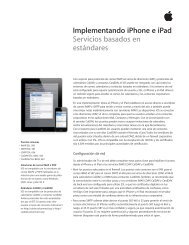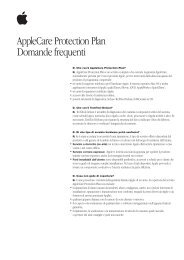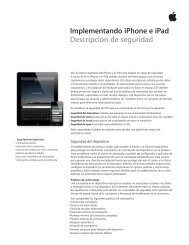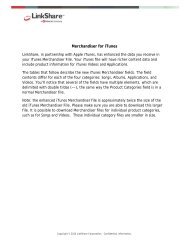In-House App Development Accelerator Guide - Apple
In-House App Development Accelerator Guide - Apple
In-House App Development Accelerator Guide - Apple
You also want an ePaper? Increase the reach of your titles
YUMPU automatically turns print PDFs into web optimized ePapers that Google loves.
Local Storage<br />
iOS provides Core Data and SQLite to help your app manage and interact with data stored on the<br />
device itself.<br />
• Core Data. The Core Data framework includes generalized and automated solutions to common tasks<br />
associated with object life cycle and object graph management, including persistence. Core Data<br />
provides a general-purpose data management solution developed to handle the data model needs<br />
of every kind of application, large or small. You can quickly defi ne your apps data model graphically<br />
and easily access it from your code. It provides an infrastructure to deal with common functionality,<br />
such as save, restore, undo, and redo, allowing you to get on with the task of building innovation into<br />
your app. Because Core Data uses the built-in SQLite data library, you don’t need to install a separate<br />
database system.<br />
• SQLite. iOS includes the popular SQLite library, a lightweight yet powerful relational database engine<br />
that’s easily embedded into an app. Used in countless apps across many platforms, SQLite is considered<br />
the de facto industry standard for lightweight embedded SQL database programming. Unlike the<br />
object-oriented Core Data framework, SQLite uses a procedural, SQL-focused API to manipulate the<br />
data tables directly. You can even use SQLite in a web app using JavaScript.<br />
Securing Your <strong>App</strong><br />
Chances are your in-house app uses sensitive corporate data that needs to be secured and protected.<br />
Many of the basic device-level safeguards, such as passcode policies and remote wipe, are available<br />
to your IT managers to administer. But regardless of these security features, it’s always a good idea to<br />
have a strategy for securing data residing within your in-house apps.<br />
To support the process of securing data in your app, iOS provides a “sandboxed” approach and requires<br />
that apps be signed so they can’t be tampered with. iOS also has a framework that facilitates secure<br />
storage of app credentials in an encrypted keychain. And it provides high-level frameworks that can<br />
be used to encrypt app data and provide secure networking. You can leverage all these capabilities<br />
within your own development process to provide a secure foundation without impacting the user<br />
experience.<br />
Planning • Design • <strong>Development</strong> • Deployment<br />
Example: Centralized Web Services<br />
A great way to simplify your back-end development is to centralize web<br />
services, particularly if your app needs to talk to multiple back-o∑ ce systems.<br />
For example, Sunbelt Rentals used .Net application servers to write scripts<br />
that could invoke stored procedures on legacy AS/400 systems as well as<br />
Microsoft CRM databases. They were then able to expose the data retrieved<br />
by .Net via XML that could be easily consumed by the mobile app.<br />
AS/400 MS SQL Servers MS CRM<br />
“ Security was a big factor in our decision<br />
to do application development for the<br />
iPhone. The iPhone o∂ ered us HTTPS<br />
security, keychain for keeping certain<br />
things private, and we were able to<br />
encrypt data.”<br />
—Keith DeBickes, JM Family<br />
22





